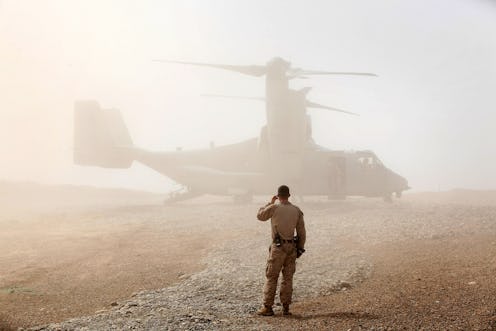News
The War In Afghanistan Is Officially Over
In 2012, Obama announced that the U.S. would withdraw its troops from Afghanistan by the end of 2014, and he's made good on his word. After 13 years, the U.S. has formally ended the war in Afghanistan. Though the U.S. and Britain ended operations in Afghanistan in October, the chapter was officially and symbolically closed on Sunday with a ceremony at NATO's military headquarters in Kabul. After marking the official end of the International Security Assistance Force (ISAF), a new international mission was announced that would see NATO in a supporting role.
During the ceremony, General John Campbell, commander of the ISAF, rolled up the green and white ISAF flag and unveiled a new one, representing a new mission and the next chapter for Afghanistan. Campbell announced the NATO-led mission Resolute Support, which would provide training, assistance, and guidance to Afghan security forces, ministries, and institutions but will not involve combat.
Campbell announced at the event that "Resolute Support will serve as the bedrock of an enduring partnership" between NATO and Afghanistan. The mission will launch on January 1, 2015, and will involve around 11,000 remaining U.S. soldiers.
After 13 years, many in Afghanistan have mixed feelings about the withdraw of foreign troops as Taliban insurgents remain a prominent and dangerous threat to this day. In fact, this year has been the most deadly since the war began with civilian casualties expected to reach 10,000 for the first time.
Before Resolute Support kicks off the next — and perhaps last — chapter, take a look back at the major events of the war in Afghanistan.
September 11, 2001
The Al Qaeda-led 9/11 attacks prompt then-president George W. Bush to initiate the war, targeting Al Qaeda's headquarters and Taliban support in Afghanistan.
October 7, 2001
The U.S. and the U.K. launch airstrike campaign Operation Enduring Freedom after the Taliban refused to extradite Osama bin Laden.
December 2001
The ISAF is established to oversee all military operations in Afghanistan and train the Afghan National Security Forces. The same month, Hamid Karzai is sworn in as chairman of an interim government replacing the defeated Taliban.
March 2002
The U.S. launches Operation Anaconda, a large-scale battle that sought to uncover and uproot Taliban and Al Qaeda holdouts.
May 1, 2003
Defense Secretary Donald Rumsfeld and Karzai announce that major combat in Afghanistan has ended and the focus has shifted to reconstruction.
August 11, 2003
NATO assumes leadership of the ISAF and its peacekeeping mission.
October 9, 2004
Karzai becomes the first democratically elected president of Afghanistan.
October 29, 2004
Osama bin Laden releases a video message claiming responsibility for 9/11 and threatening the West with more violence.
September 18, 2005
Afghanistan holds its first free legislative elections in more than 25 years, marking a significant step in the country's transition to a democratic government.
September 2008
As troop and civilian deaths climb, President Bush sends an additional 4,500 U.S. troops to Afghanistan.
February 2009
The U.S. announces another 17,000 troops, leading other NATO countries to pledge additional military support.
March 2009
Obama unveils a new strategy for the war, which will provide an additional 4,000 troops to train Afghan security forces.
December 2009
Obama announces plans to deploy another 30,000 troops to Afghanistan, bringing the total number to 100,000, but also states that U.S. troops would start withdrawing in 2011.
February 2010
NATO launches Operation Moshtarak, a major offensive that fought Taliban insurgents who had teamed up with drug traffickers in the Helmand province.
May 2, 2011
Osama bin Laden is killed in a Seal Team Six raid on his compound in Abbottabad, Pakistan.
June 22, 2011
Obama announces that 10,000 troops will come home by the end of the year and another 20,000 by the summer of 2012.
May 2012
President Karzai and President Obama sign a strategic partnership agreement between their two countries, and NATO approves an exit strategy from Afghanistan.
October 26, 2014
The U.S. and the U.K. transfer Camp Leatherneck and Camp Bastion to Afghan control, officially marking the end of their military operations in Afghanistan.
Images: Getty Images (18)
